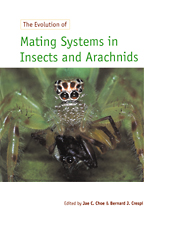Book contents
- Frontmatter
- Contents
- Contributors
- Acknowledgements
- Introduction
- 1 Evolutionary perspectives on insect mating
- 2 Sexual selection by cryptic female choice in insects and arachnids
- 3 Natural and sexual selection components of odonate mating patterns
- 4 Sexual selection in resource defense polygyny: lessons from territorial grasshoppers
- 5 Reproductive strategies of the crickets (Orthoptera: Gryllidae)
- 6 The evolution of edible ‘sperm sacs’ and other forms of courtship feeding in crickets, katydids and their kin (Orthoptera: Ensifera)
- 7 The evolution of mating systems in the Zoraptera: mating variations and sexual conflicts
- 8 The evolution of water strider mating systems: causes and consequences of sexual conflicts
- 9 Multiple mating, sperm competition, and cryptic female choice in the leaf beetles (Coleoptera: Chrysomelidae)
- 10 Firefly mating ecology, selection and evolution
- 11 Modern mating systems in archaic Holometabola: sexuality in neuropterid insects
- 12 Mating systems of parasitoid wasps
- 13 Fig–associated wasps: pollinators and parasites, sex–ratio adjustment and male polymorphism, population structure and its consequences
- 14 Evolution of mate–signaling in moths: phylogenetic considerations and predictions from the asymmetric tracking hypothesis
- 15 Sexual dimorphism, mating systems and ecology in butterflies
- 16 Lek behavior of insects
- 17 Mate choice and species isolation in swarming insects
- 18 Function and evolution of antlers and eye stalks in flies
- 19 Sex via the substrate: mating systems and sexual selection in pseudoscorpions
- 20 Jumping spider mating strategies: sex among cannibals in and out of webs
- 21 Sexual conflict and the evolution of mating systems
- Organism index
- Subject index
16 - Lek behavior of insects
Published online by Cambridge University Press: 03 May 2010
- Frontmatter
- Contents
- Contributors
- Acknowledgements
- Introduction
- 1 Evolutionary perspectives on insect mating
- 2 Sexual selection by cryptic female choice in insects and arachnids
- 3 Natural and sexual selection components of odonate mating patterns
- 4 Sexual selection in resource defense polygyny: lessons from territorial grasshoppers
- 5 Reproductive strategies of the crickets (Orthoptera: Gryllidae)
- 6 The evolution of edible ‘sperm sacs’ and other forms of courtship feeding in crickets, katydids and their kin (Orthoptera: Ensifera)
- 7 The evolution of mating systems in the Zoraptera: mating variations and sexual conflicts
- 8 The evolution of water strider mating systems: causes and consequences of sexual conflicts
- 9 Multiple mating, sperm competition, and cryptic female choice in the leaf beetles (Coleoptera: Chrysomelidae)
- 10 Firefly mating ecology, selection and evolution
- 11 Modern mating systems in archaic Holometabola: sexuality in neuropterid insects
- 12 Mating systems of parasitoid wasps
- 13 Fig–associated wasps: pollinators and parasites, sex–ratio adjustment and male polymorphism, population structure and its consequences
- 14 Evolution of mate–signaling in moths: phylogenetic considerations and predictions from the asymmetric tracking hypothesis
- 15 Sexual dimorphism, mating systems and ecology in butterflies
- 16 Lek behavior of insects
- 17 Mate choice and species isolation in swarming insects
- 18 Function and evolution of antlers and eye stalks in flies
- 19 Sex via the substrate: mating systems and sexual selection in pseudoscorpions
- 20 Jumping spider mating strategies: sex among cannibals in and out of webs
- 21 Sexual conflict and the evolution of mating systems
- Organism index
- Subject index
Summary
(The sight of a feather in a peacock's tail, whenever I gaze at it, makes me sick
Charles Darwin (Darwin, F. 1887, vol. 2, p. 296))ABSTRACT
We provide a general overview of lek behavior in insects. Initially, we draw a distinction between substrate–based and aerial (swarming) male mating aggregations. In general, males in substrate–based groups defend territories, wait for arriving females, and perform courtship prior to mating. By contrast, males in swarms typically exhibit no intrasexual aggression before female arrivals and grasp approaching females for immediate mating without courtship. Also, compared with swarms, substrate–based aggregations tend to be small, and males are more likely to produce long–range signals to attract females. We examine the relative importance of intra– and intersexual selection in substrate–based groups with (1) male aggression but no courtship, (2) male courtship but no aggression, and (3) both male courtship and aggression. The final category, groups most closely resembling ‘classical’ lek species, receives most attention; data from drosophilid and tephritid fruit flies are presented to show interspecific differences in the influence of male aggression and female choice on male mating success. Few data are available that address the evolutionary origins of lek behavior in insects. Among male–initiated hypotheses, it is most likely that males cluster at transit ‘hotspots’ where large numbers of females are likely to pass. There is no empirical support for the idea that clustering increases signal effectiveness and hence female arrivals on a per male basis. In addition, data regarding predation and group size do not consistently reveal reduced risks with increasing group size.
- Type
- Chapter
- Information
- The Evolution of Mating Systems in Insects and Arachnids , pp. 273 - 293Publisher: Cambridge University PressPrint publication year: 1997
- 53
- Cited by

